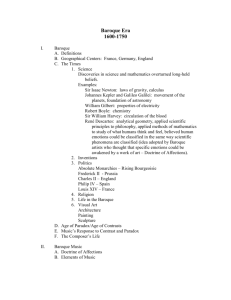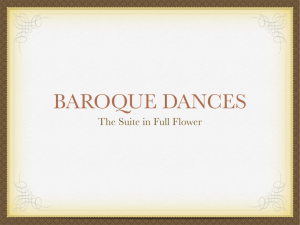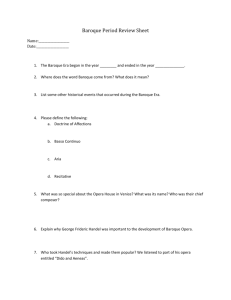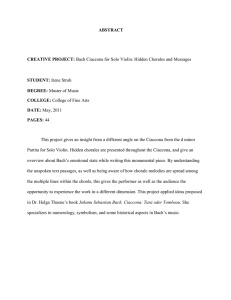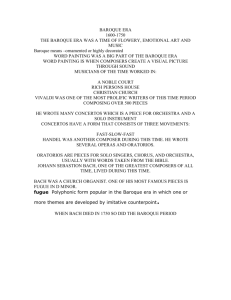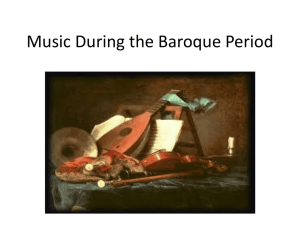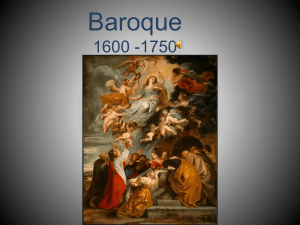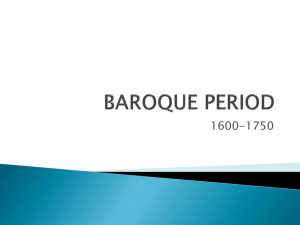• Performing a Bach Suite
advertisement
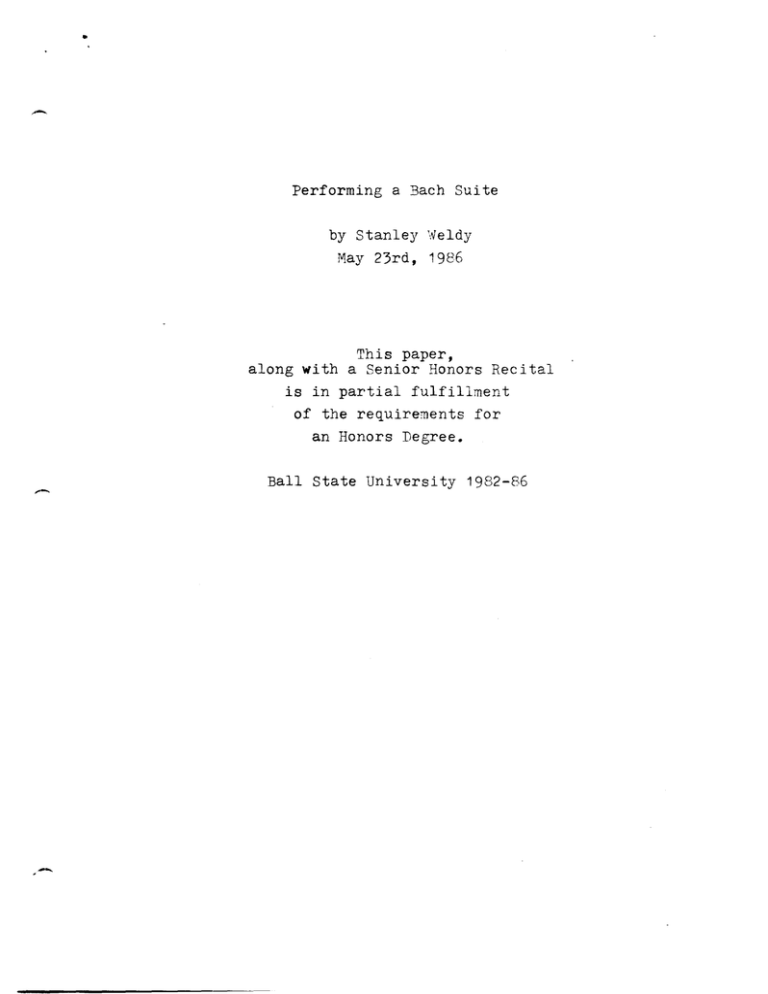
•
Performing a Bach Suite
by Stanley Weldy
May 23rd, 1926
This paper,
along with a Senior Honors Recital
is in partial fulfillment
of the requirements for
an Honors Degree.
Ball State University 1982-86
i'
•
AI
-'
BALL STATE UNIVERSITJ
SCHOOl. OF MUSIC
),
pmsents
STANlEY Wi:1.OY
viola
in a
SEMIOR RECITAL
aubted by
Eri Nakagawa. piano
"Daniel Hughes, percussion
,
;
Divertimento
FrB.n~
Adagio
Menuet
Joseph Haydn
{173~-1009)
j"
Allegro d1 motto
Suite No. 3 in C Major
Johann Stbast11fi Sach
"
for unaccompanied viola "
(1635. 17(0)
, Prelude
Allemande
-
Courante
Sarabande
BolJrr6e I
Sigut
and II
• •.• Intef'll1 sst O:-/~;'"
•
~ar1 atiQns for FOllr Drt.M:.lndY1.\'~~~'
Introduction
,
'}I "
Var. I. Adlgi0 :
'1.t. II. All egro
Vftr. III. Lyrical "
Var. IV. Andante agitato
Vir. V. S~hfirzo
Michael Cllgrass '
(b. 1932}
,
;,
"
Ii' .
Finale
Sonata forYiol. and Piano. Op. 120 No. !
Allegro apPlssionato. hi
Andante un poco Adagio
Allegretto grazioso
, V1VK.
,
Johannes Srehl'{$
( 1833-1891)
,"
Stanley Weldy is a student of Linde .1~J.
Th1srecitll is pnsented 11 partfal6rl'f111ment of tile
requ11'8111ei\ts for the degree Bachelor">'MU$ic.
U'UnRSITY HALL
,f:;,: '
Thursday. Apr1l 24. 1986
p._.
,;, '
,
Series XXXX .,;'
8:00
t·· ': '
Ntlfbe t' 148
In Kee.,:1ng With Copyrfght -Ind. Arttst Ag'NellEmts.
Recording 6Itd PhotograpMe Oev1cei'~"Hot remitted.
*Recwest Your cooperation."t~if\}'
itri·r"""
'f~:'!;~'~
~,
ru"
I
"I
OUT IJINE
-
I. History
A. J.S. Bacb: bis life
B. The Suites for unaccompanied lcello
II. Traditional performance ideas
A. Romanticism
B. The ~odern scientific approacb
III. My performance ideas
A. ,Performance pbilosopby
1. Rejection of tradition.
a. rejection of Romanticism
b. rejection of modern scientific approach
2. Straddling two entities
a. the composer
b. the audience
B. Specifics
1. tef:lpos
2. articulations
,-
-
General consensus acknowledges Johann Sebastian Bach
as the supreme composer of the Baroque Era and one of the
greatest master crafts~en in the history of Western music.
The key to his genilus lay in his ability to balance two opposing
elements. He combined immense powers of creativity and originality
with intellectual control and technical craft, executing this
balance with a perfectionYnparalleled by his peers and rarely
matched in other eras.
'
Bach was the last of eight children born to a staunch Lutheran
family in Eisenach, Germany. Only four of these children lived
to adulthood. He attendeJthe Lateinschule which provided hu~anistic
and theological studies. Records report him as being a good
student.
In 1694 J.S. Bach's mother died, and less than a year later
his father also died. Bach was only nine years old at the time.
He went to live with his brother at Ohrdruf. There he studied
at the Lyceum. His curriculum included religion, reading, writing,
arithmatic, history and natural science.
When he was 15, his brother's house became too crowded, as
three children had been born to the family since Johann Sebastian's
rarrival. Ee left and was taken in at the Michaelkirche in LUne-.....Jburg.
There he studied orthodox Lutheranism, Latin, arith~atic, history,
geography, geneology, heraldry, German poetry, and physics.
He began to teach himself composition and organ playing.
At age 17 he went to Weimar and worked as a paid lackey.
He had access to an organ which he practiced when he could.
A year later he secured an appointment as organist in a smal:
church in Arnstadt.
Bach became very skilled at the organ. When he was 22 he
accepted an important post as organist in Muhlhausen. Here he
married, and began to teach and compose in earnest. His ability
became known throughout the region.
In the next year he accepted a higher paying post at the
-
-.
court in 1.ve imar, where he stayed for nine ye ars. Six of his
children were born there. He produced major organ works and
canta.tas.
HIs noble employers at Weimar had various running disputes
among themselves during ~ach's stay. When they finally began
quibbling about the music at the court, Bach decided to leave.
He demanded realease from his contract in such bold terms that
he was jailed. He was finally released from jail and from his
position at court.
Bach took his family to the court at Cothen where he delighted
in his new job as director of music and leader of the fine orchestra.
Here he stayed for six years. During this time his wife died.
A year later he married A.nna '.ljagdalena "!ilcke, who was from
a musical fa~ily.
Finally, in 1723, he accepted a prestigious position as
Kantor in ~eipzig. He stayed in Leipzig for the rest of his
life, building fame as a virtuoso organist and composing masterpiece
after masterpiece. In the last year of his life his health was
very poor, and he eventually went blind fro~ cataract trouble.
He died on July 28, 1750.
The six suites for unacco~panied 'cello were written while
Bach was in Cothen between 1717 and 1723, most likely in 1720.
The reason for uncertainty is that no autograph manuscript in
Bacb's o'lln handwriting survives to us tOday. The only manuscripts
extant are one copied by ~ach's second wife, Anna ~agdalena,
and one copied by a colleagu.e, Ke Ilner. Several early editions
were published also. All of these sources differ in various
details. The Anna ;1agdalena manuscript has CO'TIe to be regarded
as the most accurate. She was fro";'] a musical family and was
herself a singer, and therefore was familiar with the notaion
and copying of music. According to the New Grove Dictionary,
"Anna !'1agdalena ••• in addition to her domestic tasks was a loyal
and industrious collaborator, partiCipating in performances and
copying out music ••• "
These six suites were the first pieces ever written for
2
unaccompanied 'cello.
They were probably influenced by Bach's
works for unaccompanied lute, and were leading up to the sonatas
and partitas for unaccompanied violin.
The geniJus of these pieces is that they need no accompaniment.
Through various techniques Bach allows one instrument to play
melody and harmony, in effect accompanying itself.
Through
double-stopping, broken chords, arpeggios, barriolaugue, and other
tricks of counterpoint, Bach created polyphonic, or many-voiced
music for one instrument. Often two or three of these voices
speak to each other at the same time.
The suites take the form of stylized dance suites with
standard dance movements: the Allemande, Courante, Saraband,
Bouree or Hinuet, and Gigue.
characteristic
rhyth~
Each of these dances has its own
and form.
A Prelude is placed before
these dances, making a total of six movements.
For the reason of the polyphony occuring in a single instrument
these pieces are perhaps a
cellist~-s
toughest test.
Violists,
whose Baroque repertoire is limited, also play transcriptions
of these suites. As the viola is voiced exactly one octave
above the 'cello, no change of key or other aberration is necessary,
other than simply transposing up one octave.
In the Romantic Era of the 19th century, stringed instruments
were improved. The inner construction of stringed instruments
was altered to produce a thicker, more powerful tone. The tone
of stringed instruments in the Baroque Era had been ~ore thin
and transparent. Romantic Players added a much heavier vibrato
to this new tone in order to increase the expressive potential
of the instr~~ent. Baroque players had used vibrato sparingly,
more as an orna~ent than as an essential part of the tone.
The final perfection of the Tourte bow caused major changes
in bowing styles.
The Tourte style bow was concave whereas
3aroque bows were convex.
The Tourte, a heavier bow, allowed a
smooth, legato bowing style and produced a bigger, warmer sound
from the instrument. The Baroque bow was light and springy,
and could barely be kept on the string, especially in fast passages.
Baroque players tended to use more bouncing and off-the-string
3
-
bowing styles.
The effect of all this was that Baroque music came to be
performed in a drastically different way in th Romantic Era.
Beauty of tone was the primary consideration, as the possibilties
of the new romantic instr~~ents were investigated. The music
was played much slower to allow a full tone to be dug out of
each note. Heavy romantic vibrato was applied constantly to
enhance the tone. The bowing style was very smooth and legato;
a rule of thumb in the Romantic Era was to never allow the bow
to leave the string while playing Bach.
This resulted in a very beautiful, lush tone. However,
much of the Baroque music's original meaning fell by the wayside.
The Bach 'cello suites, which were originally dance suites,
hardly felt dancelike under such heavy treatment. Performances
seemed to drag on because of the slow tempos, so performers
began to cut up the music by not taking repeats or by leaving
out movements altogether. The slow tempos and ful~~tones blurred
much of the interplay between the voices, and hence the polyphonic
effect was lost. The great composer Robert Schumann wrote out
a piano accompaniment for the suites in one edition which was
published in the 19th century. 'ro hi:n they sounded barren played
by just one instrument. This is indicative of the fact that
most musicians of the 19th century missed perhaps the most important
aspect of the suites -- their polyphony. Yet, the music survived.
It served the Romantics well. Romantic players did what they
wanted to do with the music.
Each culture produces music in its own image, and reproduces
old music in its own way. We noVi live in an age of science.
The scientific approach has finally been applied to music. Our
culture is now asking for historical acc~nacy in musical performance.
Ensembles have been formed which only use instruments made during
the Baroque Era or exact copies of such instruments. Every
school of music in the country (including Ball State's) is offering
opportunities to train in Baroque or ancient music performance
practice. The "original instru:nents" craze has spread through
North America and Europe. The idea is to go back to playing
music the way it sounded when it was new. This is analogous to
4
-
-,
removing layers of varnish and lacquer from old paintings to
reveal much different art beneath.
This new approach has produced some marvelous effects.
It has brought new life into many old works. However, it often
leaves the Romantic or older modern perfor:ner confused, angry,
or out in the cold. ','Ie can't all be experts in ancieEt perforn5.nce
practice, and we can't all own and master an original instrument.
And yet, the modern performer in this situation still wants to
play the wonderful music from the past.
In my performance of the Bach unaccompanied 'cello suite
no.3 I attempted to reject both of these schools of thought.
I desired no part of the Romantic distortions of Bach's masterwork.
However, T hardly subscribed to the "original instrument"
ideal. I took a piece originally written for the 'cello and
played it on the viola. In fact, three out of four of the pieces
on the recital were not written originally for the viola. This
does not display great concern for original instrumentation.
The performer stands between two entities: the composer
and the audience. First, the performer must try to understand
what the composer has done. Why did he write this music? ~hat
was he trying to say when he put those notes on the paper?
Once the performer has understood thiS, he must deliver these
thoughts and ideas to the audience. The audience is the most
important element in this chain. There is no music unless there
is somecme to hear it. ',Aj i thou t an audience the performer has
no job. He might as well sit in a closet and hum. ':rherefore
he owes his greatest allegiance to the audience. His most important
task is to make the composer's ideas clear to the audience.
I attempted to do this by first studying Bach's music carefully.
I tried to ignore the influence of Romantic music editors and
performers and drop any other cultural baggage that I might
have been carrying. I went back and studied the Anna T,1agdalena
manuscript and other editions as well.
Ny instru.rnen t is not "original". It was made in 1984 and
will never produce a Baroque sound. However, there is much
more to music, and to Bach's writing, than tone quality .:rone
,..-
is only the tool with which we make music. It is only the medium
through which the ideas pass. There are other more i~portant
considerations.
Romantic tempos were usually too slow. A Romantic editor
had put metronome markings in an edition I consulted, some of
which I felt were twice too slow. I attempted to take lively
dancelike tempos for the dance movements and a brilliant organtoccatta tempo for the prelude which was written as a virtuosic
display piece.
Romantic articulations tended to be very legato with almost
all the notes slurred into long bow strokes. I separated many
of the bowings and attempted to use slurs only to shape notes
into more graceful, dancelike groups. F'or exa~ple, compare a
Romantic bowing with one found in the .Ar...na !\1agdalena manuscript.
(see examples) The Baroque bowing slurs three notes and leaves
the fourth separate in each beat. This produces an elegant
dancelike feel, with the fourth note functioning as an upbeat
leading into the next beat and always drawing the music onward.
The Romantic bowing slurs two notes and two notes in each beat.
This produces a square effect, perhaps like dancing with heavy
boots on. Articulated this way the music tends to slow and
bog down. The Romantics slurred it this way because it was easier
for a legato bowing. It left no single note separate, and therefore
the bow did not have to leave the string at any time.
The entire suite was full of details such as t~is. In eac~
case I atteopted to come as near as possible to the spirit of
3ach's music. T feel that the original ideas are more important
than original instruments, and that these ideas can come through
even on modern instruments. The work that I did preparing for
this performance was a long step forward for me toward realizin2
this goal.
-..
6
-.
•
The
-.
Sc:.......e
rn 4;1 ....
j,- ,- ..
0
/
r.

